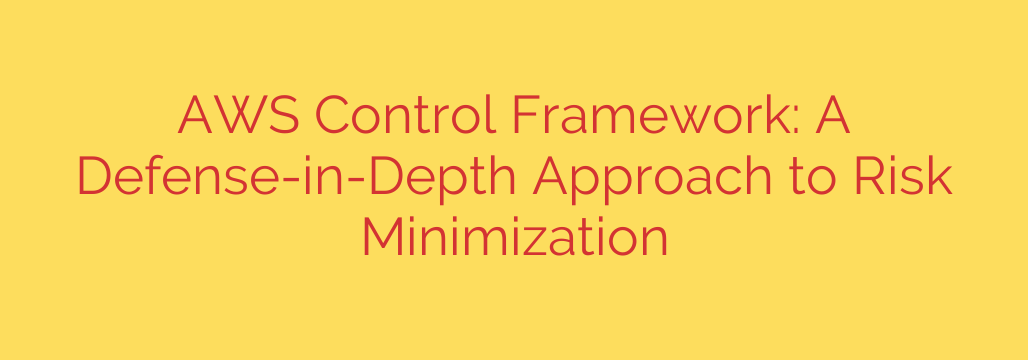
Mastering AWS Security: A Layered Defense-in-Depth Strategy
In the dynamic world of cloud computing, securing your AWS environment is not about finding a single, magic-bullet solution. Instead, the most robust and resilient security posture is built on a defense-in-depth strategy. This approach assumes that no single security control is perfect and that a layered, overlapping system of defenses is the best way to protect your critical assets from evolving threats.
By creating multiple barriers, you ensure that if one layer is breached, subsequent layers are in place to detect, contain, and neutralize the threat. This method moves beyond simple perimeter security and builds a comprehensive framework for minimizing risk across your entire AWS infrastructure.
What is Defense-in-Depth in the Cloud?
Think of securing your cloud environment like securing a medieval castle. You wouldn’t rely solely on a tall outer wall. A proper defense includes a moat, drawbridge, watchtowers, armed guards, and a fortified keep at the very center. Each layer provides a distinct form of protection, and an attacker would need to overcome all of them to reach the crown jewels.
In AWS, this translates to a multi-layered security architecture that protects your data and applications from every angle. It’s a proactive framework that integrates security controls at the network, identity, compute, and data levels.
The Core Layers of an AWS Security Framework
A successful defense-in-depth strategy in AWS involves implementing strong controls across several critical domains. Here are the essential layers you need to fortify.
1. The Identity and Access Management (IAM) Layer
This is your first and most critical line of defense. Controlling who can access what is fundamental to cloud security. If an attacker can’t get in, they can’t do damage.
- Key Controls: Implement the principle of least privilege, ensuring that users and services have only the permissions absolutely necessary to perform their tasks. Utilize IAM Roles for temporary credentials instead of long-lived access keys.
- Actionable Tip: Enforce multi-factor authentication (MFA) for all users, especially for root and administrative accounts. Regularly audit IAM policies to remove unused or excessive permissions.
2. The Network and Perimeter Layer
This layer is about controlling the flow of traffic into and out of your cloud environment. By properly segmenting your network, you can contain potential breaches and limit an attacker’s ability to move laterally.
- Key Controls: Use Amazon Virtual Private Cloud (VPC) to create logically isolated sections of the AWS cloud. Within your VPC, leverage Security Groups (stateful firewalls for EC2 instances) and Network Access Control Lists (NACLs) (stateless firewalls for subnets) to filter traffic. For web applications, deploy AWS Web Application Firewall (WAF) to protect against common web exploits like SQL injection and cross-site scripting.
- Actionable Tip: Avoid leaving sensitive ports, such as SSH (22) or RDP (3389), open to the entire internet (0.0.0.0/0). Restrict access to specific, known IP addresses.
3. The Infrastructure and Compute Layer
Your virtual servers, containers, and serverless functions are the engines of your applications. Securing this layer involves protecting the underlying operating systems and runtime environments from vulnerabilities.
- Key Controls: Ensure your Amazon EC2 instances and container images are hardened and regularly patched. Use AWS Systems Manager Patch Manager to automate the process of patching your fleets of instances. For containers, leverage Amazon ECR’s built-in vulnerability scanning to identify security issues in your images before they are deployed.
- Actionable Tip: Create a “golden AMI” (Amazon Machine Image) that is pre-hardened, patched, and configured according to your security standards. Use this as the base for all new EC2 instances to ensure consistency.
4. The Data Protection Layer
Ultimately, the goal of most attackers is to access or corrupt your data. This layer focuses on protecting your data both when it is stored (at rest) and when it is moving across the network (in transit).
- Key Controls: Encrypting data at rest and in transit is non-negotiable. Use AWS Key Management Service (KMS) to create and manage cryptographic keys. Enable server-side encryption for services like Amazon S3 and Amazon RDS. Enforce TLS/SSL for all data in transit to prevent eavesdropping.
- Actionable Tip: Enable default encryption on all new S3 buckets to ensure that data is automatically protected the moment it is uploaded. Classify your data and apply stricter encryption and access controls to your most sensitive information.
5. The Detective and Monitoring Layer
You cannot defend against what you cannot see. This final, crucial layer is about visibility. It involves logging, monitoring, and actively detecting potential security threats across your environment so you can respond quickly.
- Key Controls: Enable AWS CloudTrail across all regions to log every API call made in your account. Use Amazon CloudWatch to collect logs and set up alarms for suspicious activity. Deploy Amazon GuardDuty, an intelligent threat detection service that continuously monitors for malicious activity and unauthorized behavior.
- Actionable Tip: Configure GuardDuty to send findings to a centralized security account and set up automated alerts or remediation actions using AWS Lambda. A swift, automated response can often stop an attack in its tracks.
Building a Resilient and Proactive Security Posture
Implementing a defense-in-depth strategy is not a one-time project; it is a continuous process of assessment, refinement, and adaptation. By building a robust control framework based on these layered principles, you move from a reactive security stance to a proactive one.
This comprehensive approach ensures that even if one control fails, your organization has multiple other defenses ready to protect your valuable assets, maintain operational integrity, and build trust with your customers.
Source: https://aws.amazon.com/blogs/security/minimize-risk-through-defense-in-depth-building-a-comprehensive-aws-control-framework/








